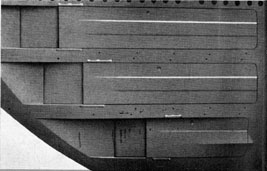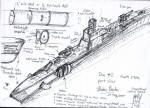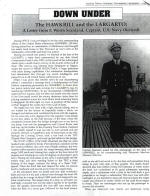Missing USS-Lagarto Submarine discovered
Written by Stephen Burton – copyright 2006
‘One of many WWII wrecks recently identified in Thai waters by
Koh Tao Wreck Research Vessel MV Trident’
The Gulf of Siam with Bangkok as its hub, has been an important international seaway stretching back over millennia. Until recent years, trade routes into Thailand overland from all neighboring countries were tenuous at best. With either mountains, wide fast flowing rivers, or impenetrable jungles preventing all shipments by land larger than could be carried by pack mule.
Such was the situation that faced Japan following its invasion of Thailand in 1941. Just one railroad joined Thailand with Singapore and with transport aircraft being the only other viable means of logistical supply, the Gulf of Siam was busy with Japanese merchant vessels transporting the heavier items needed for the war effort, plus warships protecting their vulnerable cargo against the growing threat of allied submarine action.
Just how successful submarines were in destroying Japanese naval supply lines are given in these stark figures: – The US Navy’s WWII submarine force sank over 5 million tons of enemy shipping accounting for over 60 percent of all destroyed enemy tonnage.
But US submarines didn’t have it all their own way during the deadly cat and mouse game above and below the waves, and in all, 52 US submarines and over 3,500 sub crewmen lost their lives.
USS LAGARTO – LOST
Such was to be the fate of the USS-LAGARTO, when during a joint radio co-coordinated attack of a Japanese convoy with the submarine USS-BAYA on the 3rd May 1945, the Japanese escort minelayer HATSUTAKO recorded a depth charge attack on a US submarine in 30 fathoms (55 meters) of water. The BAYA was never able to re-establish radio communications with the LAGARTO and it is assumed that it was this attack that was responsible for her sinking. The ‘unusually alert’ HATSUTAKA crew was so vigilant in defending the convoy that it was also able to successfully drive the USS BAYA off.
That the HATSUTAKA was subsequently sunk 12 days later was not by accident. The captain of a nearby US submarine USS HARKBILL was a close friend of the LAGARTOS captain, he requested and was granted permission by COMSUBPAC to divert from his patrol orders for a revenge attack. 4 torpedoes were expended against the HATSUTAKA during a prolonged attack that lasted two days. A final lucky MK14 mod 3 torpedo fired from a distance of nearly 3 miles through an allied minefield, finally blew the HATSUTAKA into two pieces while an attempt was being made by Japanese naval forces to take her under tow for repairs caused by the damage from the HAWKBILL’s earlier attacks. No survivors of the HATSUTAKA’ s sinking permitted themselves to be rescued.
On May 7th 1995 on the 50th anniversary of the LAGARTO’ s sinking, Commander Vaughn from the Los Angeles class Nuclear submarine USS New York City laid a Wreath at the presumed final resting place of the USS-Lagarto.
The exact location where USS-Lagarto was attacked and sunk remained a mystery until 19th May 2005. When just after the 60th anniversary of her sinking, Koh Tao Divers Jamie Macleod & Stewart Oehl diving from the Koh Tao based shipwreck research vessel M.V. Trident descended a shot line in 73 meters of water to investigate an underwater anomaly rising some 15 meters from the seabed close to the LAGARTO’ s last reported position of N007.55, E102.00.
The shot line landed near to the bows of the LAGARTO, and on a day of uncharacteristically good visibility at these great depths, they stood on the bottom and gazed up at the distinctive massive outline of a Balao class submarine.
Dive Review
Any dive planned to a depth of 75meters should be made using Heliox or Trimix breathing gases so as to avoid both Oxygen Toxicity and Nitrogen Narcosis at this working depth. An actual Lagarto dive plan is shown below.
From the dive plan printouts, it’s interesting to note, that for only a 25minute bottom dive, the diver has to spend 1hr 14mins carrying out very formal mixed gas decompression. It took 4 dives of this type just to swim around all 4 quadrants of the wreck taking the notes and sketches that formed the basis of the analysis in this article. In accordance with the US navy permission for diving the LAGARTO, no penetration dives at all into the living quarters of the submarine were made, and no part of the wreck was disturbed in any way.
Unbelievably during a whole day of diving, A juvenile Whale Shark joined the dive team while waiting at their long decompression stops. Divers already on the surface quickly re-entered the water to snorkel with the gentle giant. For added fun and double-jeopardy a poisonous sea snake also swam near the group until it bumped into the lens of the (until then…) totally fearless video-grapher.
Wreck Condition

The pictures and dive sketches show the 311ft long 1,500ton USS LAGARTO upright and in one piece. The sinking location lies in open ocean, and as would be expected for a dive so far out to sea, the surface visibility is excellent at around 50 meters plus. During this dive sequence, the tip of the LAGARTO’ s twin periscope tubes and conning tower pierced a silty thermo-cline that began from 60 meters and extended all the way down to the sea bed at 75 meters depth. Visibility below the thermo-cline was much reduced from that near the surface, but the wreck was still clearly visible as a submarine, even before divers reached the wreck.
During the 1st dive on the LAGARTO with over riding need to return to the ascent line so as to assure that our dive team didn’t become a ‘lost-at-sea statistics(again!) , our team ‘reeled out’ from the ascent line along the top surface of the wreck. This gave an indication of the massive size of the LAGARTO, since by the time we’d reached the bow, I’d used all of the 50meters of line on the reel.
Natural light still penetrated through the thermo-cline, but all divers were thankful of the high power technical diving torches which each diver carried with them, that gave illumination to the fine details of the wreck necessary when diving at these depths.
As Jamie’s Purple book of ‘net snag marks’ indicated, the LAGARTO has caused many fishing boats to loose their nets. These large football pitch sized nets cost upwards of USD25,000 each, and are not left on the bottom without a fight. All smaller sized items that protruded through the hull have been pulled off during attempts to wrestle free the nets, leaving only massive lumps of steel such as the conning tower, bow & stern planes, props, plus the twin 5 inch guns intact.
Final Moments
After each dive, it was possible to add more details to the dive sketch that would formally identify the USS LAGARTO. Unlike many other Balao class submarines, the LAGARTO had two 5-inch guns mounted in front of, and behind the conning tower. These were clearly visible mounted in a stowed position, which together with the wrecks location confirmed the identification.
A forward starboard torpedo door is open, and it’s possible to peer inside and confirm that it is empty. This suggests that the LAGARTO went down fighting and that a torpedo had been fired during her last moments. The rubber seals of the torpedo tube muzzle door are still in excellent condition even after 60 years underwater.



Sadly, also visible was the massive damage caused to the port quarter forward of the conning tower. The LAGARTO had plainly sustained a direct hit from a depth charge or other large explosive ordinance. The destruction caused by this device had been sufficient to entirely destroy the external steel plating that contained several large buoyancy compartments and then penetrate much further into the sub to punch a large hole through the 1 inch thick high tensile steel inner pressure bulk head that contained the crew’s living spaces.
All crew in the compartment adjacent to the damaged area would have perished instantly from the force of the explosion. Tons of water per second from the 55meters of water pressure would have rapidly entered these forward living spaces, throwing the sub off balance and negatively buoyant, and causing it accelerate rapidly nose down towards the sea bed. The subs external control planes are juxta-positioned; The foreword planes are set to the ‘dive’ position whereas the stern planes were set to ‘surface’. It may have been that with all the internal watertight doors closed, the stern compartments crews survived the initial explosion (as in the Russian Kursk submarine disaster on August 12th 2000), and that a desperate last ditch attempt was made to override the steep descent by blowing emergency buoyancy tanks and moving the aft control planes into the ‘ascend’ position from other emergency controls located aft. However, the weight of the flooded forward living spaces compounded with the destroyed forward buoyancy compartments was too much weight to overcome, and the sub stayed on the bottom.
Extract of the USS Lagarto’s co-operation with the USS Hawkbill. Courstesy of the Wisconsin Maritime Museum newsletter, http://www.wisconsinmaritime.org/
Diving the USS LAGARTO – A War Grave
The USS LAGARTO submarine is a restricted war grave. 86 American servicemen lost their lives during the sinking, and as such, she is being treated with the utmost respect which she deserves.
The Lagarto lies far out to sea, in very deep water that would prove lethal if dived breathing air. Only a hand full of people in the Far East (all known to each other) have the pre-requisite skills and financing to execute a dive to the Lagarto breathing ultra expensive Helium based Trimix… and come back alive. Thus mass tourism or casual vandalism by recreational divers to the Lagarto’s final resting place is highly un-likely.
Like all submarines, the USS Lagarto was expensive to produce, utilizing 250 ton of lead batteries, tons of bronze, copper and other non-ferrous materials for her weapons and propulsion systems, meaning that although the salvage value of a submarine in current monetary values could run to several hundred thousand dollars, her extreme depth and the complexity of any Helium saturation diving techniques necessary to facilitate any worthwhile salvage would make any commercial recovery attempts unviable.
She is currently being researched and documented by MV Trident’s team with the permission of the US Navy’s Naval Historical Center. The exact location of the Lagarto remains a closely guarded secret.
SUBVETS
Submarine Veterans or SUBVETS are a special breed. ‘Pride runs deep’ within the community of WWII SUBVET families, their children, and their grandchildren that continues to this day. All submarines are very specialized pieces of military hardware, but the origins of the LAGARTO are particularly interesting. The Manitowoc shipyard that built the LAGARTO was located hundreds of miles inland. That the US Navy department through its bureau of ships contracted a small shipbuilding company, located on the shores of Lake Michigan, about as far from the ocean by river as you could possibly imagine, to build submarines, the most difficult shipbuilding construction job known at that time is a story in itself. The Manitowoc shipbuilding company ended up building 28 of these Balao class submarines in total. WWII SUBVETS and their relatives still live in the area to this day.
Sub Crews in WWII developed a battlefield humor when writing home about the very real risks of falling victim to depth charge attacks. ‘Don’t’ worry if anything happens to me. I’ll have a 6 Million Dollar Coffin with plenty of friends…” was a common remark.
Prior to the discovery of the LAGARTO, I’d received many requests for help from SUBVET relatives and technical assistance from personnel at the Wisconsin Maritime Museum in Manitowoc in the USA.
On learning of the LAGARTO’s discovery, a Mrs. Nancy Mabin Kenney (the daughter of LAGARTO Signalman First Class William T. Mabin), established contact with the dive expedition group. Nancy contacted other surviving relatives and during July 2005 two of Nancy’s children (grandchildren of the LAGARTO crewman) traveled to Thailand to accompany the wreck research vessel for the trip that would formally identify the USS-LAGARTO.
For Nancy Mabin Kenney of Lake Leelanau, Michigan USA. and for the surviving relatives of the LAGARTO’ s crewmen, 2005 was a special year that provided closure from knowing the exact location where Husbands, fathers and grandfathers lay, and pride in the knowledge that the LAGARTO went down fighting.
“All my life, I never really knew my father, but the people who knew him well kept him alive in my memory,” Kenney said. “To think of what my mother’s generation went through with all the uncertainty during the war is just overwhelming. But now it’s up to my generation to support these men and make sure they’re honored,” she said.
On the conclusion of the final dive sequence, a memorial service was held at the LAGARTOS final resting place.
Jamie Macleod, Stewart Oehl and the divers and crew of the M.V. Trident during the USS Lagarto Memorial trip July 2005. MV Trident may be contacted at www.techthailand.com
Nancy Mabin Kenney, daughter of USS Lagarto crewman William T Mabin, Wisconsin USA
The Grandchildren of USS Lagarto crewman William T Mabin
Article References online & print:-
- http://www.techthailand.com MV Trident Wreck Research vessel main web site.
- https://www.thaiwreckdiver.com For up to date information on the USS LAGARTO
- http://www.usslagarto.org The official web site for USS Lagarto news
- http://www.navsource.org/archives/08/08371a.htm For the USS Lagarto’s home page on the authoritative ‘navsource.org’ web site
- http://www.multied.com/navy/Submarine/lagarto.html More Lagarto History
- http://www.wisconsinmaritime.org/ The Wisconsin Maritime Museum
- Veterans Day Ceremony honors the USS Lagarto Submarine veterans were honored in a Veterans Day ceremony held at Pearl Harbor Naval Station
- http://usmilitary.about.com/library/milinfo/blsubslost.htm US Submarines Losses
- http://www.maritime.org/fleetsub/ Complete WWII Operating & Maintenance manuals for a ‘Fleet Submarine’
- Ships Log for the USS BAYA (the last vessel to contact the USS Lagarto) courtesy of Mr Fred Evans, Commercial Diver
- http://uboat.net Submarine battle reports, chronology of sinkings
- ‘Wisconsin Maritime Museum newsletter’ Jul-Sep 1998 & Oct-Dec 1998 issues.
- ‘Wisconsin WWII Stories-The home front’ Video cassette from the Wisconsin maritime Museum
- ‘Fresh Water Submarines the Manitowoc Story’ by Rear Admiral William T. Nelson, published Heffner printing 1988







